Photogenetic actress Isa Pola (1909-1984) became during the 1930s and 1940s a true diva of the Italian cinema. She showed her frankness and passion for acting in such films as La canzone dell'amore (1930), La telefonista (1932) and Vittorio de Sica's I bambini ci guardano (1943).
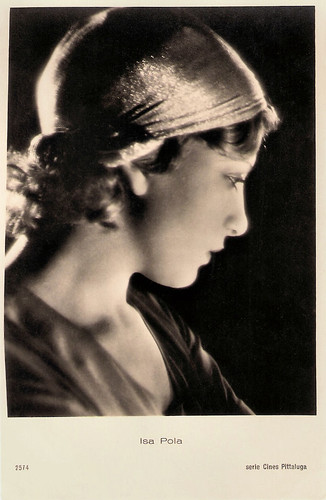
Italian postcard in the Cines Pittaluga series by Casa Edit. Ballerini & Fratini, Firenze, no. 2574. Photo: Cines Pittaluga.
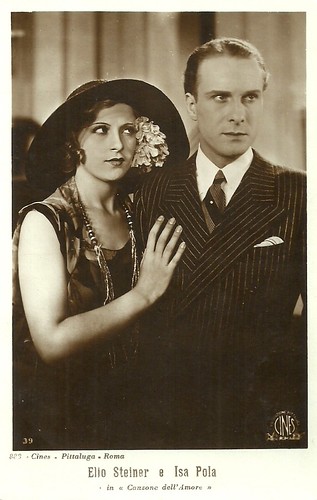
Italian postcard by Ed. G.B. Falci, Milano, no. 39. Photo: Cines. Pittaluga, Roma. Isa Pola and Elio Steiner in La canzone dell'amore (Gennaro Righelli, 1930).

Italian postcard. Photo: Pesce / Scalera Film. Isa Pola as Santuzza in Cavalleria rusticana (Amleto Palermi, 1939).

Italian postcard by Hector, no. 2.20, 1941. Photo: Pexce / Scalera Film. Isa Pola in Lucrezia Borgia (Hans Hinrich, 1940).
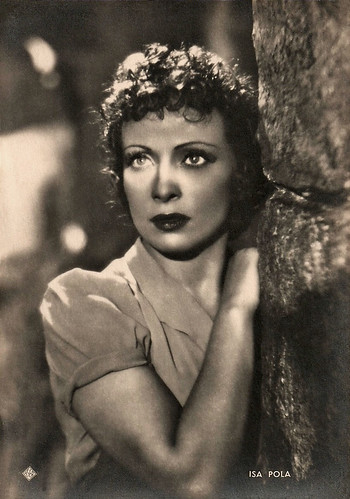
Italian card by ASER, Rome, no. 240. Photo: Pesce / Scalera Film. Isa Pola in Una signora dell'ovest/Girl of the Golden West (Carl Koch, 1942).
Isa Pola was born Maria Luisa Betti di Montesano in Bologna, Italy in 1909. Isa had a passion for acting and cinema at an early stage, and picked as her stage name Pola. She was beautiful, photogenic, had something captivating and almost perverse.
She made her film debut with a small part in Martiri d'Italia/Martyrs of Italy (Domenico Gaido, 1927). Other small parts followed in which she was type-casted as the evil adventuress. This eventually lead to her first major part in Myriam (Enrico Guazzoni, 1928).
After the introduction of sound film, Pola’s career really took off. She played the antagonist of Dria Paola in the first Italian sound film La canzone dell’amore/The song of love (Gennaro Righelli, 1930). From that film on Pola became a true diva of the Italian sound cinema. With her photogenic qualities, frankness and pleasant voice she broke with the tradition of the languid divas of the silent era.
She continued her success throughout the 1930s with such hit films as Terra madre/Mother Earth (Alessandro Blasetti, 1931) opposite Leda Gloria, La Wally (Guido Brignone, 1931) featuring Germana Paolieri, L'ultima avventura/The Last Adventure (Mario Camerini, 1932), La telefonista/The switchboard Operator (Nunzio Malasomma, 1932), Acciaio/Steel (Walther Ruttmann, 1933) and the comedy L'anonima Roylott/The anonymous Roylott (Raffaello Matarazzo, 1936).
Her part as a serious and streetwise telephone operator in La telefonista contrasted with her previous vamp roles and gave her image a new, interesting twist. Thanks to this versatility, her career quickly marched on. As a popular diva of the Italian screens, she starred together with the big male stars of those years: Fosco Giachetti, Gino Cervi, Rossano Brazzi and Antonio Centa, alternating the type of the perfidious, insatiable woman with the honest and pious wife, and the defenseless girl with the adulterous bourgeois lady. She played Santuzza in Cavalleria rusticana (Amleto Palermi, 1939) opposite Leonardo Cortese as Turiddu, she performed the title role in Lucrezia Borgia (Hans Hinrich, 1940), and did the female lead of Arianna in the now lost Western Una signora dell’ovest/Girl of the Golden West (Carl Koch, 1942) with Michel Simon, Rossano Brazzi and Valentina Cortese.
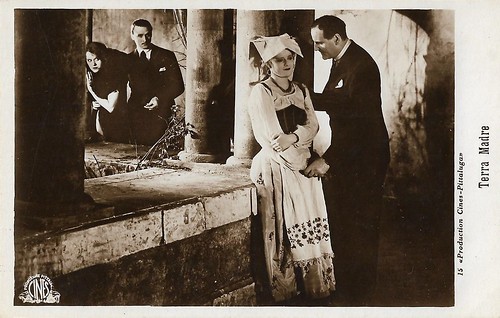
Italian postcard by G.B. Falci, Milano, no. 15. Photo: Cines-Pittaluga, Roma. Postcard for the Italian early sound film Terra madre/Mother Earth (Alessandro Blasetti, 1931), with on the right Leda Gloria as Emilia and Sandro Salvini as Duke Marco. Left in the back, Isa Pola as Daisy and her friend, played by Giorgio Bianchi.
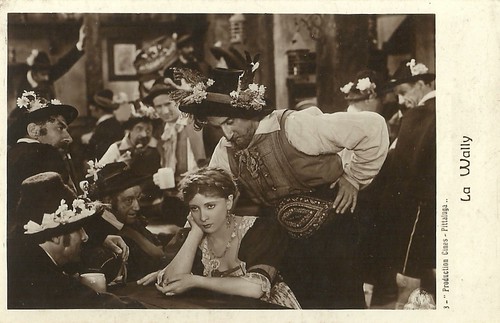
Italian postcard. Photo: Cines-Pittaluga. Carlo Ninchi and Isa Pola in La Wally (Guido Brignone, 1932).

Italian postcard., no. 6. Photo: Cines-Pittaluga. Germana Paolieri and Isa Pola in La cantante dell'opera (Nunzio Malasomma, 1932).
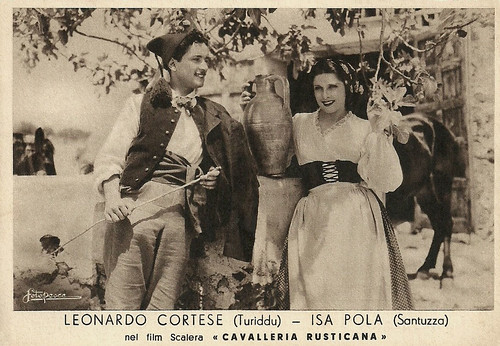
Italian postcard by Scalera, Roma/Zincografia, Firenze. Photo: Pesce. In the drama Cavalleria rusticana (Amleto Palermi, 1939), Isa Pola and Leonardo Cortese had the leads. The film was based on the work of Giovanni Verga, which was also turned into an opera by Pietro Mascagni.
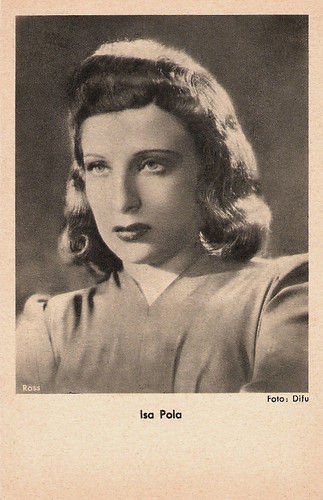
German postcard by Das Programm von Heute, Berlin / Ross. Photo: Difu. Isa Pola in Il ponte di vetro/Bridge of Glass (Goffredo Alessandrini, 1940).
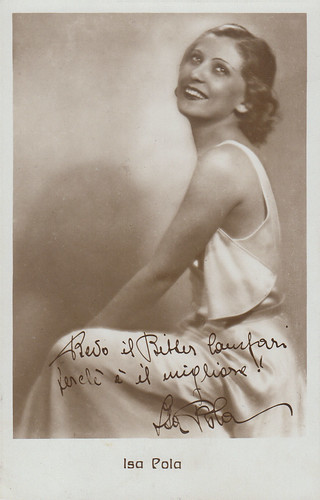
Italian postcard. Collection: Marlene Pilaete.
A highlight in Isa Pola's career was her part of the wife of Emilio Cigoli who betrays her husband with Adriano Rimoldi in Vittorio De Sica’s realist melodrama I bambini ci guardano/The Children Are Watching Us (1943).
Joel Kanoff at Film Reference: "with I bambini ci guardano, De Sica teamed with Cesare Zavattini, who was to become his major collaborator for the next three decades. Together they began to demonstrate elements of the post-war realist aesthetic which, more than any other director except Visconti and Rossellini, De Sica helped shape and determine.
Despite the overt melodrama of the misogynistic story (a young mother destroys her family by deserting them), the filmmaker refused to narrow the perspective through an overwrought Hollywoodian mise-en-scène, preferring instead a refreshing simplicity of composition and a subdued editing style. Much of the film's original flavor can be traced to the clear, subjective mediation of a child, as promised in the title."
In the postwar era, Isa Pola returned to the cliché of the perfidious and adulterous woman in Furia/Fury (Goffredo Alessandrini, 1947) with Gino Cervi, Ombre sul Canal Grande/Shadows on the Grand Canal (1951, Glauco Pellegrini) with Antonio Centa, and Tre storie proibite/Three Forbidden Stories (1952, Augusto Genina) with Gabriele Ferzetti as the mother of Lia Amanda.
Until the late 1950s, Isa Pola stayed active in cinema, while pursuing a modest career on television on the side in the years 1957-1959. After having started on stage in revues with Nino Besozzi, Antonio Gandusio and Enrico Viarisio, Pola turned towards prose theatre.
Thanks to her clear voice and her perfect mastering of Venetian dialect she excelled on stage with the Compagnia del Teatro Veneto, in particular in 1936 with La vedova (The widow) and in 1947 alongside Cesco Baseggio in Il bugiardo (The Liar).
In addition to comedies by Carlo Goldoni, she also performed in texts by Giacinto Gallina, George Bernard Shaw (Non si sa mai/You Never Can Tell), Alberto Moravia (Gli indifferenti/The indifferent), Torquato Tasso (Intrighi d'amore/Intrigues of love), Gabriele D'Annunzio (La fiaccola sotto il moggio/The light under a bushel) and Luigi Pirandello. She was also striking in comical theatre alongside Alberto Bonucci in 1958.
After having retired, Isa Pola died in 1984 in Milan, at the age of 74.

Italian postcard by Rizzoli, Milano, 1937. Photo: Demanins.

Italian postcard by Rizzoli, Milano, 1938.

Italian postcard by Rizzoli, Milano, 1939. Photo: Pesce.

Italian postcard by Rizzoli, Milano, 1940. Photo: Pesce. Portrait for Cavalleria rusticana (Amleto Palermi, 1939).
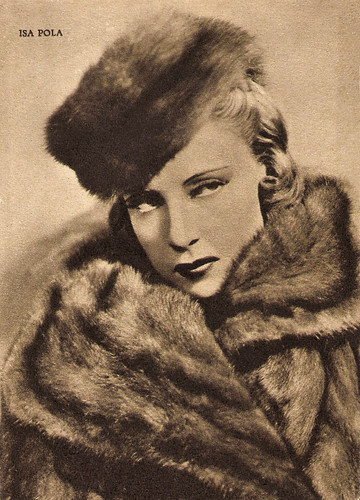
Italian postcard by Rizzoli, Milano, 1941.

Italian postcard by Rizzoli, Milano, 1942. Photo: Scalera Film.
Sources: Joel Kanoff (Film Reference), CinéArtistes (French), Wikipedia (Italian), and IMDb.

Italian postcard in the Cines Pittaluga series by Casa Edit. Ballerini & Fratini, Firenze, no. 2574. Photo: Cines Pittaluga.

Italian postcard by Ed. G.B. Falci, Milano, no. 39. Photo: Cines. Pittaluga, Roma. Isa Pola and Elio Steiner in La canzone dell'amore (Gennaro Righelli, 1930).

Italian postcard. Photo: Pesce / Scalera Film. Isa Pola as Santuzza in Cavalleria rusticana (Amleto Palermi, 1939).

Italian postcard by Hector, no. 2.20, 1941. Photo: Pexce / Scalera Film. Isa Pola in Lucrezia Borgia (Hans Hinrich, 1940).

Italian card by ASER, Rome, no. 240. Photo: Pesce / Scalera Film. Isa Pola in Una signora dell'ovest/Girl of the Golden West (Carl Koch, 1942).
Something Captivating and Almost Perverse
Isa Pola was born Maria Luisa Betti di Montesano in Bologna, Italy in 1909. Isa had a passion for acting and cinema at an early stage, and picked as her stage name Pola. She was beautiful, photogenic, had something captivating and almost perverse.
She made her film debut with a small part in Martiri d'Italia/Martyrs of Italy (Domenico Gaido, 1927). Other small parts followed in which she was type-casted as the evil adventuress. This eventually lead to her first major part in Myriam (Enrico Guazzoni, 1928).
After the introduction of sound film, Pola’s career really took off. She played the antagonist of Dria Paola in the first Italian sound film La canzone dell’amore/The song of love (Gennaro Righelli, 1930). From that film on Pola became a true diva of the Italian sound cinema. With her photogenic qualities, frankness and pleasant voice she broke with the tradition of the languid divas of the silent era.
She continued her success throughout the 1930s with such hit films as Terra madre/Mother Earth (Alessandro Blasetti, 1931) opposite Leda Gloria, La Wally (Guido Brignone, 1931) featuring Germana Paolieri, L'ultima avventura/The Last Adventure (Mario Camerini, 1932), La telefonista/The switchboard Operator (Nunzio Malasomma, 1932), Acciaio/Steel (Walther Ruttmann, 1933) and the comedy L'anonima Roylott/The anonymous Roylott (Raffaello Matarazzo, 1936).
Her part as a serious and streetwise telephone operator in La telefonista contrasted with her previous vamp roles and gave her image a new, interesting twist. Thanks to this versatility, her career quickly marched on. As a popular diva of the Italian screens, she starred together with the big male stars of those years: Fosco Giachetti, Gino Cervi, Rossano Brazzi and Antonio Centa, alternating the type of the perfidious, insatiable woman with the honest and pious wife, and the defenseless girl with the adulterous bourgeois lady. She played Santuzza in Cavalleria rusticana (Amleto Palermi, 1939) opposite Leonardo Cortese as Turiddu, she performed the title role in Lucrezia Borgia (Hans Hinrich, 1940), and did the female lead of Arianna in the now lost Western Una signora dell’ovest/Girl of the Golden West (Carl Koch, 1942) with Michel Simon, Rossano Brazzi and Valentina Cortese.

Italian postcard by G.B. Falci, Milano, no. 15. Photo: Cines-Pittaluga, Roma. Postcard for the Italian early sound film Terra madre/Mother Earth (Alessandro Blasetti, 1931), with on the right Leda Gloria as Emilia and Sandro Salvini as Duke Marco. Left in the back, Isa Pola as Daisy and her friend, played by Giorgio Bianchi.

Italian postcard. Photo: Cines-Pittaluga. Carlo Ninchi and Isa Pola in La Wally (Guido Brignone, 1932).

Italian postcard., no. 6. Photo: Cines-Pittaluga. Germana Paolieri and Isa Pola in La cantante dell'opera (Nunzio Malasomma, 1932).

Italian postcard by Scalera, Roma/Zincografia, Firenze. Photo: Pesce. In the drama Cavalleria rusticana (Amleto Palermi, 1939), Isa Pola and Leonardo Cortese had the leads. The film was based on the work of Giovanni Verga, which was also turned into an opera by Pietro Mascagni.

German postcard by Das Programm von Heute, Berlin / Ross. Photo: Difu. Isa Pola in Il ponte di vetro/Bridge of Glass (Goffredo Alessandrini, 1940).

Italian postcard. Collection: Marlene Pilaete.
Perfidious and Adulterous Woman
A highlight in Isa Pola's career was her part of the wife of Emilio Cigoli who betrays her husband with Adriano Rimoldi in Vittorio De Sica’s realist melodrama I bambini ci guardano/The Children Are Watching Us (1943).
Joel Kanoff at Film Reference: "with I bambini ci guardano, De Sica teamed with Cesare Zavattini, who was to become his major collaborator for the next three decades. Together they began to demonstrate elements of the post-war realist aesthetic which, more than any other director except Visconti and Rossellini, De Sica helped shape and determine.
Despite the overt melodrama of the misogynistic story (a young mother destroys her family by deserting them), the filmmaker refused to narrow the perspective through an overwrought Hollywoodian mise-en-scène, preferring instead a refreshing simplicity of composition and a subdued editing style. Much of the film's original flavor can be traced to the clear, subjective mediation of a child, as promised in the title."
In the postwar era, Isa Pola returned to the cliché of the perfidious and adulterous woman in Furia/Fury (Goffredo Alessandrini, 1947) with Gino Cervi, Ombre sul Canal Grande/Shadows on the Grand Canal (1951, Glauco Pellegrini) with Antonio Centa, and Tre storie proibite/Three Forbidden Stories (1952, Augusto Genina) with Gabriele Ferzetti as the mother of Lia Amanda.
Until the late 1950s, Isa Pola stayed active in cinema, while pursuing a modest career on television on the side in the years 1957-1959. After having started on stage in revues with Nino Besozzi, Antonio Gandusio and Enrico Viarisio, Pola turned towards prose theatre.
Thanks to her clear voice and her perfect mastering of Venetian dialect she excelled on stage with the Compagnia del Teatro Veneto, in particular in 1936 with La vedova (The widow) and in 1947 alongside Cesco Baseggio in Il bugiardo (The Liar).
In addition to comedies by Carlo Goldoni, she also performed in texts by Giacinto Gallina, George Bernard Shaw (Non si sa mai/You Never Can Tell), Alberto Moravia (Gli indifferenti/The indifferent), Torquato Tasso (Intrighi d'amore/Intrigues of love), Gabriele D'Annunzio (La fiaccola sotto il moggio/The light under a bushel) and Luigi Pirandello. She was also striking in comical theatre alongside Alberto Bonucci in 1958.
After having retired, Isa Pola died in 1984 in Milan, at the age of 74.

Italian postcard by Rizzoli, Milano, 1937. Photo: Demanins.

Italian postcard by Rizzoli, Milano, 1938.

Italian postcard by Rizzoli, Milano, 1939. Photo: Pesce.

Italian postcard by Rizzoli, Milano, 1940. Photo: Pesce. Portrait for Cavalleria rusticana (Amleto Palermi, 1939).

Italian postcard by Rizzoli, Milano, 1941.

Italian postcard by Rizzoli, Milano, 1942. Photo: Scalera Film.
Sources: Joel Kanoff (Film Reference), CinéArtistes (French), Wikipedia (Italian), and IMDb.
1 comment:
Post a Comment